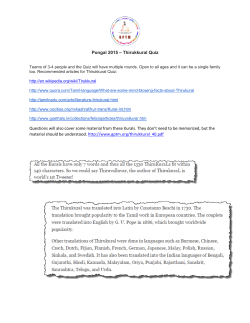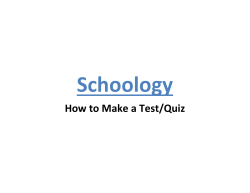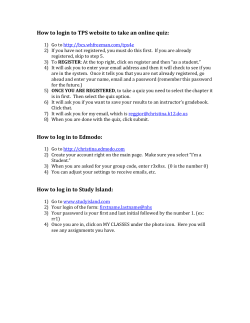
Coulomb's Law Answer Key - Rockwood Staff Websites
Electrostatics - Forces, Fields and Gauss' Law
AP Physics C
OBJECTIVES:
Upon the completion of this unit you should:
a) Understand the concept and source of electric charge and be able to calculate the magnitude and direction of the
force on charges due to other specified charges using Coulomb's law and/or electric fields.
c) Construct and interpret an electric field diagram and calculate the magnitude and direction of the electric field
produced by multiple charges s.
d) Analyze the motion of a charged particle in an electric field
e) Be able to use the principle of superposition to calculate by integration; the electric field of a straight. uniformly
charged wire, at the center of a circular arc of charge. on the axis of a thin ring of charge, a uniformly charged disk.
parallel charged planes, coaxial cylinders. and concentric spheres.
j) Students should understand Gauss's Law, so they can:
. (1) State the law in integral form. and apply it qualitatively to relate flux and electric charge for a specified
swface.
(2) Apply the Iml' to determine the electric fieldfor a planar. spherical, or cylindrically symmetric charge
distribution and the charge density or total charge on a slllface in terms of the electric field near the slllface.
TEXTBOOK READING:
Chapter 21: Electric Charge and Electric Field
Chapter 22: Gauss's Law
II. APPROXIMATE
SCHEDULE
M 1/5
Charge and Force Exploration & Coulomb's Law
Tu 1/6
Forces on Charge Particles
W 1/7 Electric Fields of Charge Pmticles
Th 1/8 Life is not a point chm'ge - Electric Field by Integration
F
1/9
Work on Integration Posters
M
Tu
W
Th
F
1/12
1/13
1/14
1/15
1/16
M 1/19
Tu 1/20
W 1/21
Th 1/22
F
1/23
Independent practice
Motion in an electric Field
Gauss' Law
Independent practice
Independent practice
No School- Martin Luther King Day
Force and Field Homework Quiz
Gauss Law HomewOl'k Quiz, handout pre-test
Review
50.pt Quiz FOl'ces and J<'ields
III. ZERO HOUR LABS
F 1/9 Force on a pith ball Lab
*** on-line Charges and Field Lab
III, ASSIGNMENTS:
FOl'ce and Field Homework Quiz
Gauss Law Homework Quiz, handout Ill'e-test
Force and Field Quiz
DUE DATES:
F 1/16
W 1/21
DUE
Tu
W
F
DATES:
1/20
1/21
1/23
Name,
AP Advanced Physics
Coulomb's Law Written
_
Problems
1.
Two small balls, each of mass 10 g, are attached to silk threads 1 m long and hung from a common point,
When the balls are given equal quantities of negative charge, each thread makes an angle of 20° with the
vertical.
(a) Draw a diagram showing all the forces on each ball.
(V\ :: • 0\
l'-J
~:
~1~'
----
\....::
~
~E
\ V'\'\
e ::'LD
~w'+C
r
<>
'(' -:. . 1J<l4
(b) Find the magnitude of the charge on each ball. (1.36xlO.6C)
i
0
c;..'f\ 1..\)
'"
~
et
'tJAY"'?J:>0
~ \<-q,
-
(p'i>
1..I/
('2-
l~v-e
,,~o
tCU"\
~
(~t.'l'tj2( ,0\) ("I. i) \
-'-'J \
J
"I
~
'f -: .l#,,'"
fuy- q,2')
r<'~
~;=J I. ,"&S'f.-10-1"2.(
-= (\{\~
'1. _
't .
2. '111"
'2.
_----(-2.
f
o
0( -::
-::\.<6 S JC.\O-'7.
c.,
\
a::
/. '?:>L.o II 10
L.:lt:.-
)C\0
_'- C )
-~
A charge -3 x 10'9 C is placed at the origin of an xy-coordinate system. and a charge 2 x 10.9 C is placed on
the positive y-axis at y= 4 em.
(a) If a third charge 4 xlO.9 C ;s now placed at the point (x= 3 em. y= 4 em). find the components of the total
force exerted on~h;s charge ~~ the other two. (Fx=+5.41xlO.5N. Fy=-3.46xlO'5N)
_
_
2.
2...
•.
~
!(fJ;
- I~l:
• \-\ ,- \
'L9.'2 ::
-1)(\0
:z.)I. \0
-"I
<t~= l-\)(IO.~C
.ol-t
~ a ::.----;;
,0::>
C
.t:'1.\N-\:-=~
j
\o,..,~
~e=C9;qo"l)(3)(\D~)(L.t)l\D'X0't)
_----
C ,@l. ol.j",
• oS!>
I.e.::
~.l..ltR)(.\O-sN
LL...::----------.
;}l"\oJ\
(-'j)l
')
_
3. Point charges of 2 x 10-9 C are situated at each of three corners of a square whose side is 0.20 m. What
9
would be the magnitude and direction of the resultant force on a point charge of -1 x 10- C if it were placed
(a) at the center of the square? (F,••=9.05xlO-7 N. 45°)
_""1
0.1.f="~-\:~ q.05XIO N
't
't
r,,": v.l""!>\£\0
-f'j"
-1
N
-1
v.OS)c ID
N
\
APAdvanced Physics
Name.
1. a. What is the strength and directian of the electric field at the position of point P in the
figure to the right?
_
@'"'
50(1:'1
I(.
I
SO(m
"om
)
p
@'"'
b. If the 3 nC change on the bottom of the figure is replaced with a -3 nC charge what is the new strength
and direction of the electric field at point P?
2. A - 1.0 nC charge is located at the origin. Points 1, 2, and 3 have (x,y) coordinates of (1 em, 0 em), (0 em, 1 em)
and (1 em, 1 em) respectively. Determine the electric field in vector notation at each of these locations and show
the vectors on an electric field diagram on the grid at the right.
~,-..
-.
.. ... .,.!
-1.
"
;-;
2.
~.
---
3.
3. A 10.0 nC charge is located at position (x,y)
a. -225,000 i N/C?
b. (161,000
c. (21,600
i+
i-
80,500
28,800
J ) N/C?
J ) N/C?
=
.-
•.
.
.
- ,. -- -- --
.~-;
(1.0 em, 2.0 em). At what (x,y) positions is the electric field:
.
--
.
IT
© Copyright 2025





















